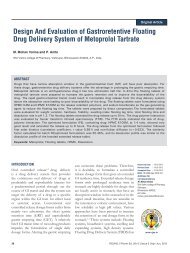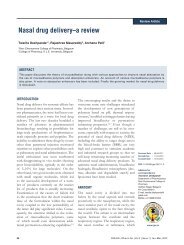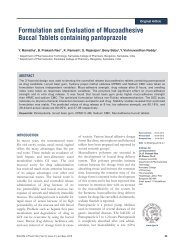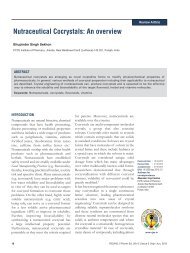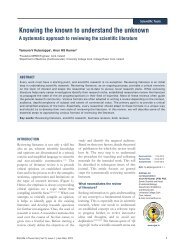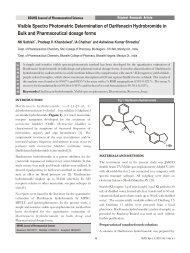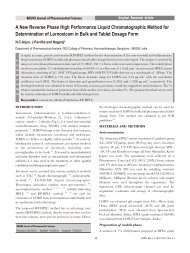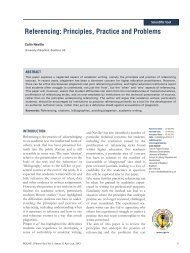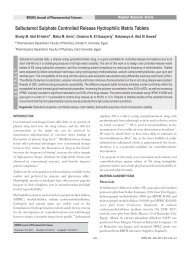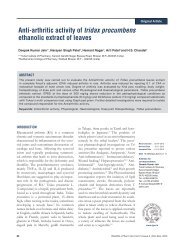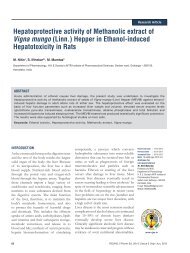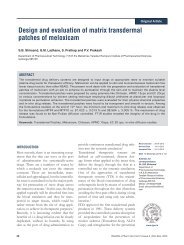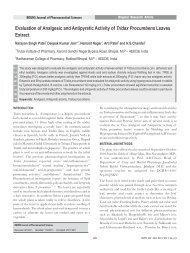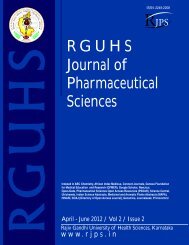Chitosan Loaded Mucoadhesive Microspheres of Gliclazide - Journal
Chitosan Loaded Mucoadhesive Microspheres of Gliclazide - Journal
Chitosan Loaded Mucoadhesive Microspheres of Gliclazide - Journal
You also want an ePaper? Increase the reach of your titles
YUMPU automatically turns print PDFs into web optimized ePapers that Google loves.
A B S T R A C T<br />
RGUHS <strong>Journal</strong> <strong>of</strong> Pharmaceutical Sciences<br />
Formulation and Evaluation <strong>of</strong> <strong>Mucoadhesive</strong> Buccal Drug Delivery System <strong>of</strong><br />
Metoprolol Tartrate by Using Central Composite Design<br />
1 2<br />
Prakash Rao B* and Gandhi Purvesh<br />
Original Research Article<br />
1 Department <strong>of</strong> Pharmaceutical Technology, Karnataka College <strong>of</strong> Pharmacy, Bangalore, Karnataka, India.<br />
2. Department <strong>of</strong> Pharmaceutics, Visveswarapura Institute <strong>of</strong> Pharmaceutical Sciences, Bangalore, Karnataka, India.<br />
The central composite design was used to develop the controlled release buccoadhesive tablets containing metoprolol tartrate as drug<br />
candidate. Carbopol 934P and hydroxy propyl cellulose (HPC) were taken as formulation factors (independent variables). Bioadhesive<br />
strength, drug release after 8 hours, T and release exponent (n) were taken as responses (dependent variables). The polymers had<br />
50%<br />
significant effect on bioadhesive strength and in vitro drug release. It was found that carbopol gives higher bioadhesive strength than<br />
HPC. Comparatively HPC controls the drug release greater than carbopol. The optimized formulation follows non-Fickian release<br />
mechanism. The FT-IR and DTA studies indicate no physico-chemical interaction. Stability studies revealed that optimized formulation<br />
was stable. The predicted values <strong>of</strong> drug release at 8 hrs, bioadhesive strength, T release exponent, n are 64.26%, 44.84 gm, 6.10<br />
50%,<br />
hrs, 0.658 and actual values are 60.45%, 43.52 gm, 6.46 hrs, and 0.673 respectively.<br />
Keywords: Metoprolol tartrate, Central composite design, Buccoadhesive, Hydroxy propyl cellulose, Carbopol 934, DTA<br />
INTRODUCTION<br />
In recent years, the transmucosal route like oral cavity, ocular,<br />
nasal, rectal, vaginal <strong>of</strong>fers the many advantages than the<br />
peroral route. These include an avoidance <strong>of</strong> both hepatic<br />
and intra-alimentary canal metabolism within GI tract. The<br />
oral mucosal cavity for drug administration has received<br />
much more attention because <strong>of</strong> its unique advantages over<br />
other oral transmucosal routes. The buccal route is suitable for<br />
sustain and controlled release administration <strong>of</strong> drug because<br />
<strong>of</strong> its less permeability and buccal mucosa has expanse <strong>of</strong><br />
smooth and relatively immobile mucosa. The sublingual route<br />
is suitable for rapid onset <strong>of</strong> action because <strong>of</strong> its high<br />
1<br />
permeability <strong>of</strong> the mucosa and rich blood supply . And the<br />
problems such as hepatic first pass metabolism and<br />
degradation <strong>of</strong> drug in GIT can be overcome by using the<br />
buccal route. Buccal drug delivery facilitates safe and easy<br />
2<br />
removal <strong>of</strong> dosage form in cause <strong>of</strong> toxicity . Various buccal<br />
3<br />
adhesive dosage forms like discs, microspheres and bilayered<br />
4<br />
tablets have been prepared and reported by several research<br />
5<br />
groups .<br />
<strong>Mucoadhesive</strong> polymers are essential in the development <strong>of</strong><br />
buccal drug delivery system. This polymer provides intimate<br />
contact between the dosage form and the absorbing tissue and<br />
6<br />
increase the retention time . Increasing the retention time <strong>of</strong><br />
the dosage form is essential in the development <strong>of</strong> this system<br />
RGUHS <strong>Journal</strong> <strong>of</strong> Pharmaceutical Sciences<br />
Received: 18/1/2011, Modified: 22/5/2011, Accepted: 1/6/2011<br />
146<br />
and it has been reported that increase in retention time with<br />
7, 8<br />
an increase in the mucoadhesivity <strong>of</strong> the system . In the<br />
literature, buccoadhesive drug delivery system for drugs like<br />
9 10 11<br />
carvedilol , clotrimazole and sodium fluoride are reported.<br />
Metoprolol Tartrate (MT) is a selective beta receptor blocker<br />
1<br />
used in treatment <strong>of</strong> several diseases <strong>of</strong> the cardiovascular<br />
system, especially in hypertension, angina pectoris, cardiac<br />
arrhythmias and myocardial infraction. The half life <strong>of</strong> MT is<br />
3 to 4 hours. Metoprolol is completely absorbed after oral<br />
administration, but bioavailability is low (< 40%) because <strong>of</strong><br />
12<br />
first pass metabolism . The short half life and severe first pass<br />
metabolism <strong>of</strong> metoprolol tartrate make it suitable for<br />
administration via buccal route that provides controlled drug<br />
delivery and by passing first pass effect.<br />
The effect <strong>of</strong> the quantity <strong>of</strong> carbopol 934 (A) and expanded<br />
form <strong>of</strong> HPC (B) were selected as independent variables. In<br />
vitro bioadhesive strength, drug release after 8 hours, T 50%<br />
(Time for 50% drug release) and diffusion coefficient (n) were<br />
selected as response variables. Computer-aided optimization<br />
technique, using central composite design (CCD), was<br />
employed to investigate the effect <strong>of</strong> two independent<br />
variables (factors) on drug release parameters and bioadhesive<br />
13<br />
strength .<br />
All response variables were fitted to linear, quadratic, 2FI<br />
model and regression analysis was carried out to get a<br />
quantitative relationship between the dependable and the<br />
analysed independent variables.<br />
RJPS, Jul - Sep, 2011/ Vol 1/ Issue 2



